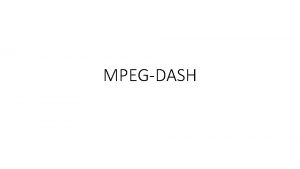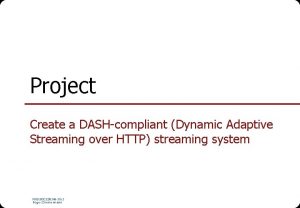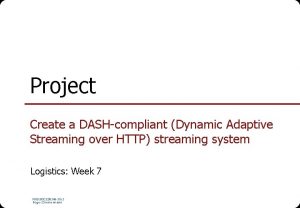Quality selection for Dynamic Adaptive Streaming over HTTP















- Slides: 15

Quality selection for Dynamic Adaptive Streaming over HTTP with Scalable Video Coding T. Andelin, V. Chetty, D. Harbaugh, S. Warnick, and D. Zappala ACM Mmsys ’ 12

Motivation SVC offers enhancements not provided by traditional DASH architectures 10% increase in the bitrate for spatial and SNR scalability A segment’s quality can be increased anytime before its playback deadline

Problem Determine which block is selected next Depend on available bandwidth Under which conditions should a client download with a diagonal policy, and how can it select the slope ? Solution Optimal Simulation

Problem Formulation Try to maximize: Left term: mean of qualities Any zero element quality score = 0 Right term: quality variation

Optimal Policies – Constant Rate λ=0 Discard quality variation Increase while the cumulative bandwidth can hold additional block Floor. Vertical λ>0 Consider quality variation Increase only one time while the cumulative bandwidth can hold additional blocks

Optimal Policies – Variable Rate Dynamic programming N segments m decisions w = 0 or 1 block per request w decided by probability N * m steps

Optimal Policies – Variable Rate (cont. )

Simulation Study DP limited to small videos Policies Vertical Mean Vertical Diagonal Horizontal Truncated Normal Rate Model Markov Rate Model

Truncated Normal Rate Model Download rate Mean of the normal distribution: μ ( 0. 25 <= μ < 6 ) Standard deviation of the distribution: σ (0 <= σ < 3 ) Gets simulated 200 times on a 1 hour video for each pair

Truncated Normal Rate Results Horizontal Low mean Low SD Mean. Vertical

Truncated Normal Rate Results Horizontal More buffer space Vertical Low performance

Markov Rate Model Rate change is somewhat continuous Nodes represent rates Rate: αi +ε ( 0. 5 <= α <= 2. 5, ε=0. 1 ) Arcs represent transition probabilities to adjacent nodes 0. 02 <= p <= 0. 98 7 nodes 200 simulated hours for each pairs

Markov Results Flattest diagonal does best overall Horizontal policy requires 10 times buffer than others

Conclusion Diagonal quality selection policy does a good job of balancing both the quality score and quality variation. Keep buffer requirements low Future work is to develop a dynamic diagonal policy

Discussion How to decide the order of segments? Different overhead on three dimension in SVC. It is hard to conduct the real experiment.
 Dynamic adaptive streaming over http implementation
Dynamic adaptive streaming over http implementation Balancing selection vs stabilizing selection
Balancing selection vs stabilizing selection Artificial selection vs natural selection
Artificial selection vs natural selection K selected
K selected Natural selection vs artificial selection
Natural selection vs artificial selection Difference between continuous and discontinuous variation
Difference between continuous and discontinuous variation Example of stabilizing selection
Example of stabilizing selection Clumped dispersion
Clumped dispersion Natural selection vs artificial selection
Natural selection vs artificial selection Two way selection and multiway selection in c
Two way selection and multiway selection in c Multiway selection
Multiway selection Procedure of pure line selection
Procedure of pure line selection Transferered
Transferered Over the mountains over the plains
Over the mountains over the plains Siach reciting the word over and over
Siach reciting the word over and over Explain how to handing over and taking over the watch
Explain how to handing over and taking over the watch




























